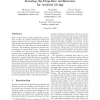Free Online Productivity Tools
i2Speak
i2Symbol
i2OCR
iTex2Img
iWeb2Print
iWeb2Shot
i2Type
iPdf2Split
iPdf2Merge
i2Bopomofo
i2Arabic
i2Style
i2Image
i2PDF
iLatex2Rtf
Sci2ools
CCS
2006
ACM
2006
ACM
Securing the drop-box architecture for assisted living
Home medical devices enable individuals to monitor some of their own health information without the need for visits by nurses or trips to medical facilities. This enables more continuous information to be provided at lower cost and will lead to better healthcare outcomes. The technology depends on network communication of sensitive health data. Requirements for reliability and ease-of-use provide challenges for securing these communications. In this paper we look at protocols for the drop-box architecture, an approach to assisted living that relies on a partiallytrusted Assisted Living Service Provider (ALSP). We sketch the requirements and architecture for assisted living based on this architecture and describe its communication protocols. In particular, we give a detailed description of its report and alarm transmission protocols and give an automated proof of correspondence theorems for them. Our formulation shows how to characterize the partial trust vested in the ALSP and use the...
| Added | 20 Aug 2010 |
| Updated | 20 Aug 2010 |
| Type | Conference |
| Year | 2006 |
| Where | CCS |
| Authors | Michael J. May, Wook Shin, Carl A. Gunter, Insup Lee |
Comments (0)

